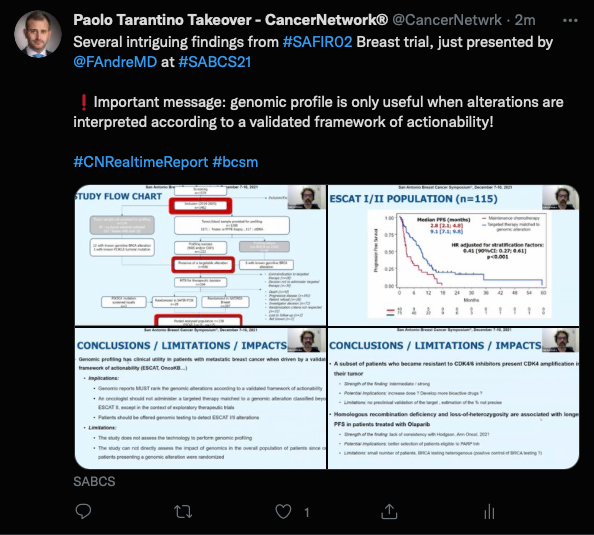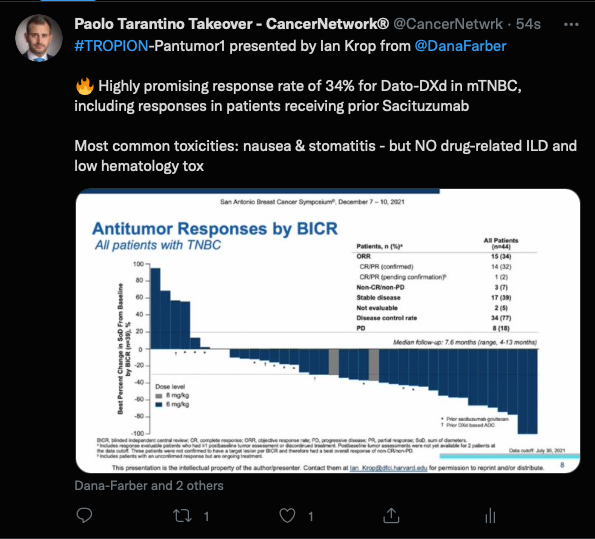CancerNetwork® Recaps Tarantino’s Twitter Takeover at SABCS 2021
Paolo Tarantino, MD, hosted a Twitter Takeover during the San Antonio Breast Cancer Symposium where he discussed abstract presentations and key takeaways in a #CNRealTimeReport.
Paolo Tarantino, MD, a clinical research fellow at Dana-Farber Cancer Institute, Boston, MA

Every December, the San Antonio Breast Cancer Symposium brings together experts in the field of cancer treatment to discuss breakthroughs data and ongoing clinical research for improving outcomes across different disease states. No matter the results, these new advances are brought to the fore to guide clinicians to find the best treatment for their patients.
During the first day of the conference, CancerNetwork® held a Twitter takeover hosted by Paolo Tarantino, MD, a clinical research fellow at Dana-Farber Cancer Institute in Boston. Tarantino posted about abstracts being presented in a #CNRealTimeReport, where he detailed the major takeaways and important messages from each of the presentations.
NeoTRIPaPDL1 Trial
Tarantino began the discussion with the first look at data from the phase 3 NeoTRIPaPDL1 trial (NCT02620280). “GS1 starts with a deep dive into the IMC phenotype of TNBCs in #NeoTrip trial by @BianchiniGP from @SanRaffaeleMI,” he wrote.
Tweet of the NeopTRIPaPDL1 Trial

Data from the study, which examined nab-paclitaxel (Abraxane) plus cisplatin with or without atezolizumab (Tecentriq), revealed the possibility of response prediction with imaging-mass cytometry for patients with triple-negative breast cancer. IMC provided greater insight into the heterogeneity of TNBC that is not typically available with bulk protein or gene expression information only.
Higher expression of 2 cell phenotypes—PD-L1–positive, IDO-positive antigen-presenting cells (APCs) and CD56-positive neuroendocrine (NE) epithelial cell—were associated with higher pathologic complete response rates with atezolizumab. In those with PD-L1–positive, IDO-positive APCs who received atezolizumab, pCRs were 64.6% vs 24.6% for those with high and low expression, respectively (P <.001).
To investigate the association between biomarkers and pCR rates, a high-dimensional imaging of the tumor, tumor-stroma interface, and the adjacent stroma were used.
SAFIR02_BREAST and SAFIR-PI3K Trials
Tweet of the SAFIR02 Trial

Next, Tarantino look to the randomized pooled analysis of phase 2 SAFIR02_BREAST (NCT02299999) and SAFIR-PI3K (NCT03386162) trials, which demonstrated survival improvement was possible when targeted therapy was matched based on multigene sequencing in HER2-negative breast cancer. The median progression-free survival (PFS) for patients with ESCAT I/II genomic alterations who received matched therapy was 9.1 months (90% CI, 7.1-9.8) compared with 2.8 months (90% CI, 2.1-4.8) with the maintenance chemotherapy (adjusted HR, 0.41; 90% CI, 0.27-0.61; P <.001).
Patients treated on the trials received 6 to 8 lines of induction chemotherapy, and the 238 of 1462 without progression who had actionable genomic alteration were randomized to matched targeted therapy (n = 157) or maintenance chemotherapy (n = 81).
Investigators found that a significant PFS difference was not found in the overall population between targeted therapy and chemotherapy (adjusted HR, 0.77; 95% CI, 0.56-1.06; P = .109). However, other markers, like homologous recombination deficiency on those with BRCA mutations who received olaparib (Lynparza), was associated with prolonged PFS (HR, 0.32; 95% CI, 0.12-0.83; P = .013).
“Important message: genomic profile is only useful when alterations are interpreted according to a validated framework of actionability,” Tarantino wrote.
TROPION-PanTumor01Trial
Tweet of the TROPION-PanTumor01 Trial

Next, Ian E. Krop, MD, PhD, presented on a group of patients with advanced or metastatic triple-negative breast cancer (mTNBC) who were treated with datopotamab deruxtecan (Dato-DXd) and saw high response rates in the phase 1 TROPION-PanTumor01 trial (NCT03401385). At the median follow-up of 7.6 months, patients (N = 44) had an overall response rate (ORR) by blinded independent review of 34% with 14 confirmed complete or partial responses. The disease control rate was 77%.
“Highly promising response rate of 34% for Dato-DXd in mTNBC, including response in patients receiving prior sacituzumab,” Taratino wrote.
At median follow-up of 8.8 months, the ORR was 52% in patients in patients with TNBC who did not receive treatment with a Topo I inhibitor–based antibody-drug conjugate.
This treatment showed no new safety signals, with the most frequent treatment-emergent adverse effects (TEAE) being nausea, stomatitis, vomiting, and fatigue. A total of 98% of patients experienced at least 1 TEAE, of which 45% were grade 3 or higher.
A phase 3 study is currently underway investigating this treatment in hormone receptor–positive, HER2-negative breast cancer and another phase 3 trial in TNBC is planned.
KEYNOTE-355 Trial
Tweet of the KEYNOTE-355 Trial

Finally, findings from the phase 3 KEYNOTE-355 trial (NCT02819518) were presented and revealed a significant survival benefit with pembrolizumab (Keytruda) plus chemotherapy for patients with locally recurrent inoperable or metastatic TNBC with a combined PD-L1 combined positive score (CPS) score of 10 or more that has not been previously treated.
When combining pembrolizumab plus chemotherapy, a median overall survival of 23.0 months was found compared with 16.1 months with chemotherapy alone in those with PD-L1 CPS of 10 or higher (HR, 0.73; 95% CI, 0.55-0.95; P = .0093). Additionally, the 18-month OS rates were 58.3% with pembrolizumab and 44.7% with chemotherapy.
The median PFS was 9.7 months in the pembrolizumab group vs 5.6 months with chemotherapy alone in those with a PD-L1 CPS of 10 or higher (HR, 0.66; 95% CI, 0.50-0.88). The 12-month PFS rate in the pembrolizumab group was 39.1% and 23.0% in the chemotherapy.
However, not all patients demonstrated a PFS benefit from the addition of pembrolizumab, such as those in the PD-L1 CPS less than 1 (HR, 1.09; 95% CI, 0.78-1.52) and 1 to 9 groups (HR, 0.85; 95% CI, 0.65-1.11).
“The [standard-of-care] threshold for use of pembro in mTNBC remains PDL1 CPS ≥10,” Tarataino concluded.
To view the full Twitter takeover, search #CNRealtimeReport on Twitter
Gedatolisib Combo With/Without Palbociclib May Be New SOC in PIK3CA Wild-Type Breast Cancer
December 21st 2025“VIKTORIA-1 is the first study to demonstrate a statistically significant and clinically meaningful improvement in PFS with PAM inhibition in patients with PIK3CA wild-type disease, all of whom received prior CDK4/6 inhibition,” said Barbara Pistilli, MD.